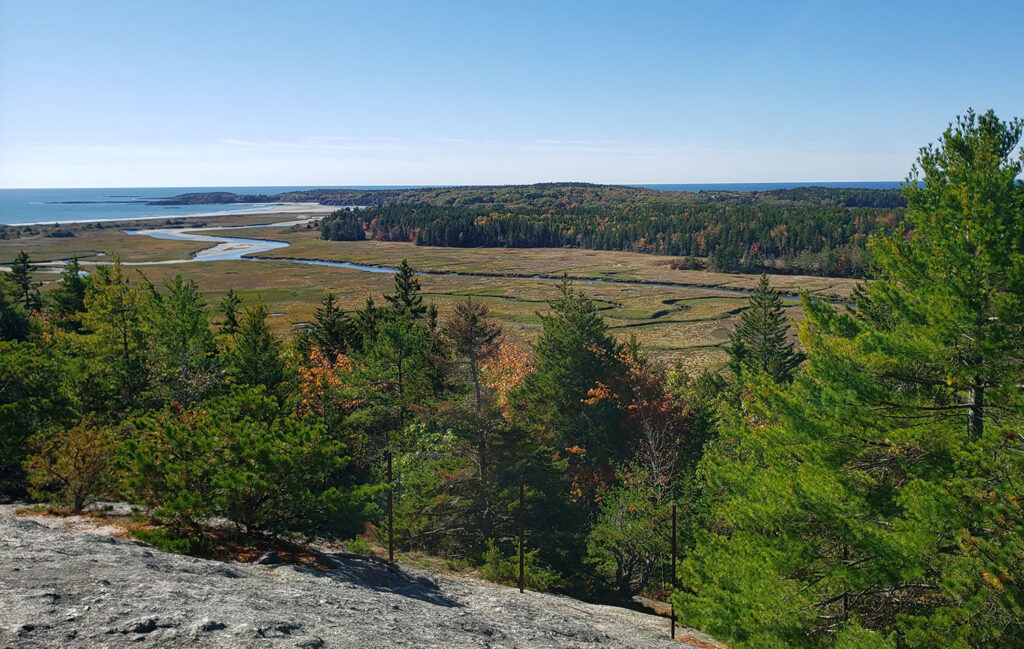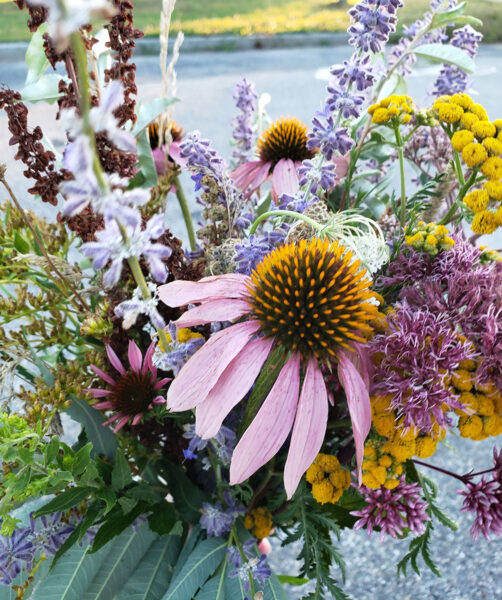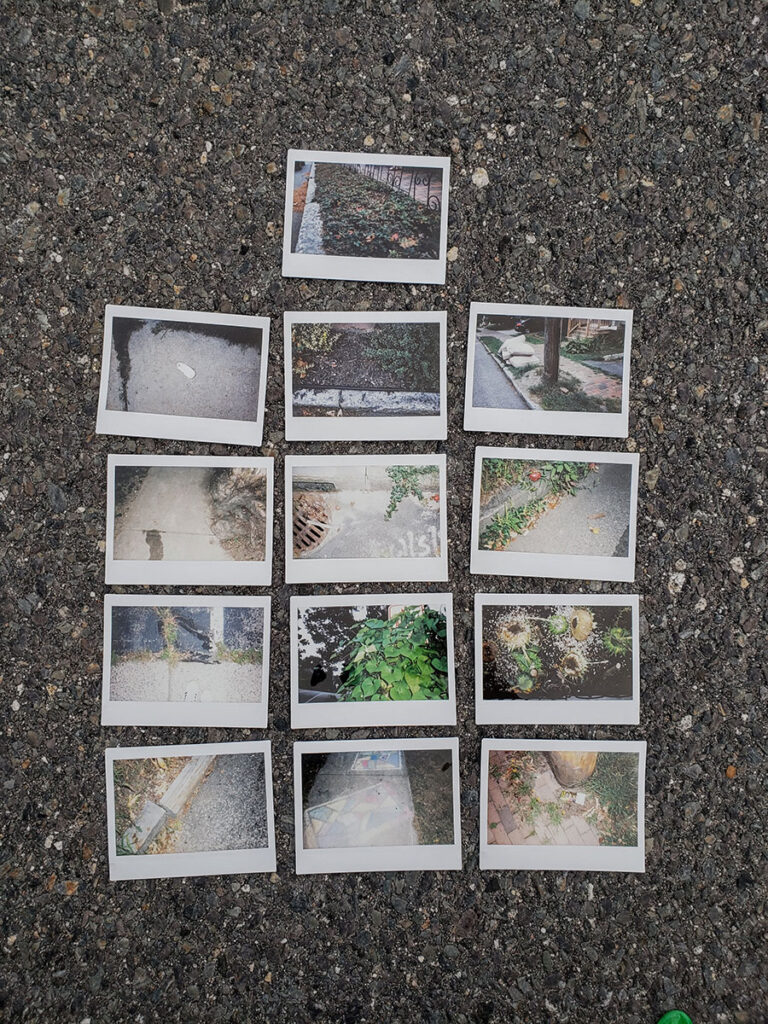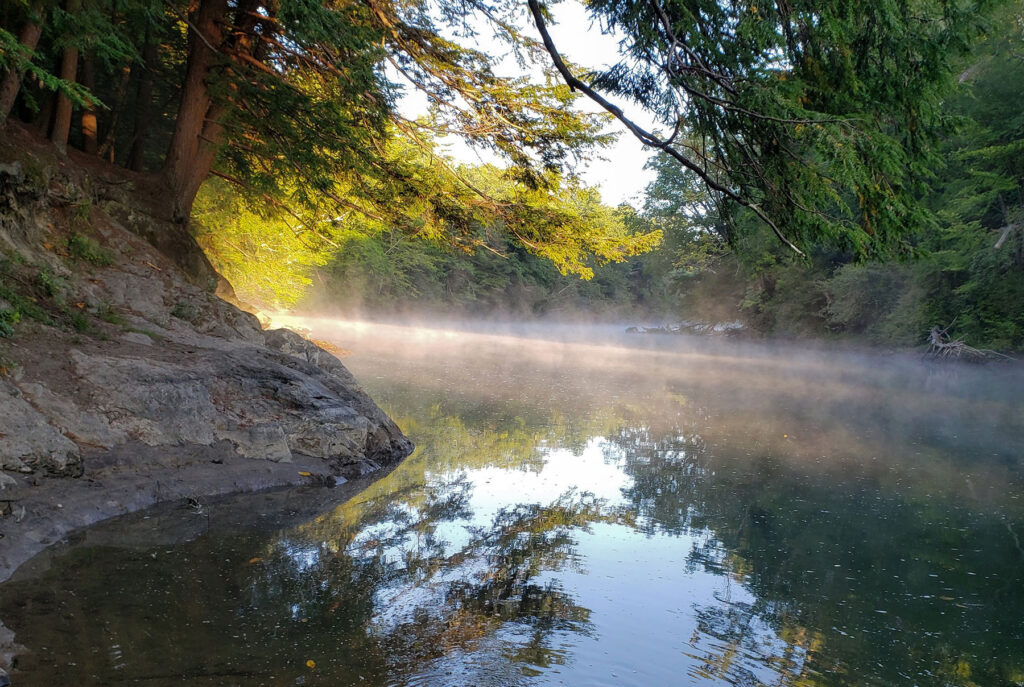by Elyse Grams
From above, high on the rocky face of Morse Mountain, a group of participants in Palimpsest, a walk led by Beverly Johnson and Julie Poitras Santos, looked down upon the salt marsh below to see the ditches cut some two hundred years ago by settler hands, lingering like scars. From this vantage point we saw nearly the whole of the marsh, which Beverly emphasized culls ten times more carbon from our atmosphere than a plot of forest of similar size. Curving through the land gentle and soft, salt water wound its way up the land, mixing with a fresh water stream that fed grasses a few thousand years older than our country. Vulnerable, golden, wind ragged, and alive the salt marsh holds memory, the earth remembers. Created as a glacier retreated, it soldiered on, becoming the home to dozens if not hundreds of species of plants, fish, animals, birds, and insects. Later it acted as a migration site for Abenaki peoples before being claimed, ditched, drained, and used as cattle feed for white settlers who fought with the land and the people already living beside it, trying to tame them both.
Hosted by Speedwell Projects and curated by Julie Poitras Santos, Palimpsest was the last in a series of walks as part of the show PLATFORM PROJECTS/WALKS: ecologies of the local. The six walks I attended were an opportunity to observe, listen to, learn from, and redefine my relationship with Portland and its many histories. The walks became an intersectional reckoning as participants were asked to consider their relationship to the land, the ever changing climate, and the Wabanaki peoples who have always lived here. Each exploration on foot slowed us down and required new ways of responding to place and our bodies within it. There is value in walking, of seeing the world go by at precisely the speed of your body. I still feel fairly new to Portland but I long to make a life here. These walks made me feel like I belonged but also made me deeply consider the role of the settler in the history of the Dawnland.

I’ll admit that I attended the early walks skeptically. My mile-a-minute brain didn’t think that slowing down any further would be a particularly useful way for me to spend my time when the year already felt unendingly long. After all, I had been brought up in colonial mindsets — nature is for taming, nature is “other.” I knew that it was important to preserve and protect nature but often that came at the personal cost of my not engaging with it. If I wasn’t in it, I couldn’t “ruin” it.
I have never been more pleased to be so wrong.
Walking with Mikhu Paul, Maliseet artist and writer, in August was familiar. I started the pandemic as a student and I had deeply missed the structure of an educational experience. She knew nearly every plant we saw, greeting them like old friends. Throughout Rhythms in a Tiny Universe, we listened to poetry, chewed on mint leaves we found growing on the trail, and spoke about the ongoing drought and its effect on the landscape. The whole forest was our classroom. Overturning logs to peek at hidden worlds, squinting our eyes to discern the layers of color that surrounded us, or plucking a leaf off a fern to make a study of its repeating patterns — we weren’t walking to get anywhere. We were walking to remember that we weren’t alone.
Foraging for local flowers with John Sundling of Plant Office at Marginalways built on themes from Mikhu Paul’s walk. We meandered through the forgotten parts of Portland — the side of a highway, weed patches behind a cluster of businesses, cracks in the pavement where non-native species have crept in — looking for the plants that no one would miss. Armed with little more than gardening shears, rubber bands, and a persistent attention to our surroundings each participant came away with a little piece of Portland that is oft overlooked. Throughout the walk John pointed out a variety of invasive plants that seem to flourish in the background of city life. We talked about his purposeful use of some of them in his practice but also how plants like Japanese Knotweed are best left untouched by amateur foragers as they have a tendency to spread even further when disturbed.

A few weeks later in the soft dawn light, I watched as a member of the In Kinship Fellowship, an interdisciplinary creative research collective, thanked the river before greeting it myself. The mist danced on the water and the light changed our bodies as the sun crested over the trees. Around the bend we could hear the roar of the Presumpscot falls: the last remaining undammed section of the river. As we transitioned from night to day during the walk wəčkáwαpan, dawn approaches, we followed the tradition of Wabanaki guiding as we walked, connecting Native and non-Native people through the experience of being together by the river. The trees dropped branches and leaves throughout the canopy making their presence known — watching and listening to us just as we were watching and listening to them. At the falls we stopped to talk about the history of the river, how Chief Polin of the Presumpscot tribe walked to Boston twice in the 1730s to protest the damming of the river by white settlers that threatened his people’s food supply. Completely ignored by white governments, he did not surrender quietly. He armed his people to fight for their access to the river, access that had been theirs for generations. In 1756 he was killed in what is now the town of Windham by Stephen Manchester, who was deemed a hero by fellow settlers and later had an elementary school named after him.1 After Chief Polin’s death his legacy didn’t just fade, it was erased, as historians and descendants of Manchester wrote his contributions to the Presumpscot people out of history. Manchester School is still open, proudly bearing a plaque honoring his service to the settlement; my partner works there today.
At each walk I found myself considering an action or an idea I had never spent much time with, reevaluating my relationship with place and attention. This was never more evident examining Vestibule of [the] Hell [Strip] with Addy Smith-Reiman. These tiny patches of grass and dirt mark the boundary of publicly- and privately-owned land, owing to their placement in front of suburban homes and the city’s need to access them to maintain underground infrastructures. Each individual plot is an absurd monument to rogue landscaping: some built up with elaborate garden beds, tree plantings, and Keep Off signs; others coordinated with neighbors to create pollination corridors for bees. I am permanently aware of my own hell strip now, which sits in front of my apartment building, half dead from constant salting and overgrown with weeds. If I’m still here next spring maybe I’ll guerilla seed it with some clover as Addy is doing with hers. Although non-native, clover is a carbon sink and is good at repairing damaged soil in preparation for future plantings. This is a small way I can give back a little of the love my first home in Portland has given me.

On the second to last walk I attended we took the ferry out to Long Island for Long Island Drift with Jan Piribeck, a local artist and Professor at University of Southern Maine, to observe and record the high tide at Fowlers Beach and its encroachment on the land firsthand. As the earth has warmed and the sea levels have risen, Piribeck told us, the king tides — which are the highest tides — have gotten higher and higher. Just a stone’s throw from the water’s edge sits a small pond, home to a myriad of birds and other wildlife. For the past few years Piribeck has been charting the rise of the ocean, concerned with its proximity to the freshwater. Even a small change in the salinity of the water brought on by cresting tides would permanently change the ecosystem, would permanently reshape the coast. From the edge of the beach I watched my partner trace the tide, barefoot in the freezing water. He walked back and forth, up and down the shoreline trying to keep pace with the waves as they rose to kiss me sitting in the sand. His sudden need to follow the water’s journey felt urgent and necessary, like when the last piece of a puzzle finally clicks into place. The tide was always faster, rushing, running, flowing unevenly, as quickly as it could. It painted shadows in the surf and on the beach. The water was rising to meet me. The water is rising to meet us all. At the rate the planet is warming I fear we are not doing enough to keep up.
Facts and figures about global warming and the melting of the ice caps mean next to nothing on paper and everything when you’re staring at the sea. Each of the walks I attended reinforced that my body is complicated in the history of these places. As I exited the Presumpscot River Trail Preserve into suburban Portland the shift was sudden; the sunlight harsh in the absence of the forest. I thought back to the invasive species we gathered on the side of the highway with John. It was and is hard to separate myself from them.
I will leave you with some of the questions I am considering in the aftermath of my experiences on these walks: How will long-term climate change permanently affect Maine’s ecosystem, coastline, and workforce? What are we doing to right the wrongs of hundreds of years of settler land abuse? Why aren’t we doing more to address indigenous sovereignty and give the land back to their care? How do we express the urgency of these issues in equitable and accessible ways? Where can more cross-disciplinary collaboration like ecologies of the local help these causes?
Unlearning colonial relationships with land and people is a lifelong pursuit. We can only begin to tackle it together.
PLATFORM PROJECTS/WALKS: ecologies of the local took place from August 20–October 10, 2020, as walks throughout Greater Portland, Maine. PLATFORM PROJECTS/WALKS: ecologies of the local invited the community for free, artist-led walks and talks regarding local ecology and climate-related changes. A partner exhibition at Speedwell Projects focuses on walking art and ecology. Artists include Kim Beck, Susan Bickford with Rachel Alexandrou, Tracey Cockrell, Viviane Le Courtois, Elaine K. Ng, In Kinship Fellowship, Mikhu Paul, Jan Piribeck, Julie Poitras Santos with Beverly Johnson, Asata Radcliffe, Todd Shalom, Brian Smith, Addy Smith-Reiman, and John Sundling.
- Eric Russell, “Memorial to Abenaki Leader Killed in 1756 Unveiled in Westbrook,” The Portland Press Herald, September 30, 2018. ↩
Elyse Grams received her BFA from the University of Texas at San Antonio in 2017 and her MFA from the Maine College of Art in 2020. Her work was selected for the 2020 CMCA Biennial in Rockland, ME. She was a 2019 fellow at the Artist Campaign School and a 2019 Resident at Watershed Center for Ceramic Arts. Her work has been exhibited in solo exhibitions at Revenant Gallery, San Antonio, TX, and at S.M.A.R.T. Project space in San Antonio, TX. Other work has been shown in group shows in Texas, Tennessee, New Hampshire, and Maine. She has curated exhibitions at Corporate Gallery in San Antonio, TX, the Window Space at Maine College of Art, in Portland, ME, and at New Systems Exhibitions, in Portland, ME. Grams lives and works in Portland, ME.


